Text
Why does Junji Ito's work turn into bad anime adaptations
Over the years, several anime adaptations have been made to the works of the master of horror, and all of them turned out underwhelming, acquiring pretty mediocre reviews. However, it's not like the source material is bad, we all know of Junji Ito's incredible storytelling and impressive artwork. This raises a question: why doesn't Junji Ito's work translate well into anime adaptations?
To answer this, let's dive more specifically into two factors: art style and the genre of his works.
Art Style
Junji Ito has a very unique art style that fits perfectly with the horror stories he creates. Take a look at a panel from his short story, Lovesick Dead (or Undying Love) of a mysterious boy who appears during foggy days.

Ito skillfully uses shading and the contrast between light and dark to create an ominous atmosphere, and the fact that the manga is drawn in monotone colors only further enhances this effect.
Furthermore, he uses a lot of lines and hatching to create detail, giving his artwork a grotesque look and an uneasy feeling. You can see this in the following scene from Uzumaki, where the protagonist's dad curls himself up in a barrel, forming the spiral shape.

Both of these features are difficult to translate into anime, as it would take too long to draw each frame (we know that the anime industry is very harsh and demanding). As a result of the flat colors and simplified designs, the story loses part of its charm. You can see by the comparison between the manga and the anime in this scene from Tomie.
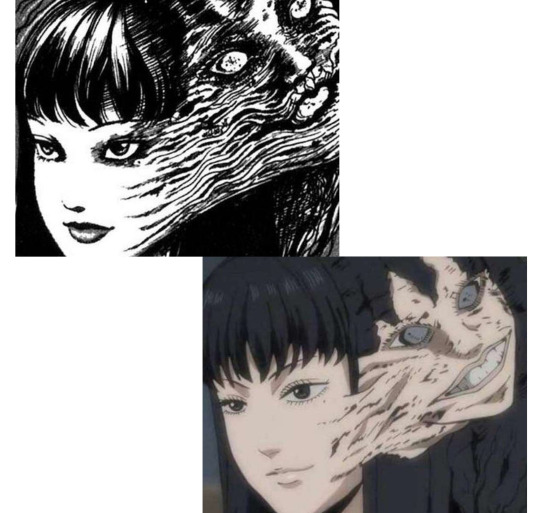
Genre
This is more of me talking in general, but horror anime usually don't compare to the manga (of course, there are exceptions). In my opinion, the best way to enjoy horror manga is late at night, alone, in complete silence. Anime takes away a lot of the suspense. In the case of the Junji Ito Collection, not only did they use a j-rock song for the opening song, the background music is often inappropriately used, destroying the otherwise ominous atmosphere. This makes the overall experience of watching the show less enjoyable and could be a reason why many people disliked the series.
Final Thoughts
The reason why I decided to make this post is that I recently found out there's going to be an anime adaptation for Uzumaki, coming out in October 2022 (it was actually announced a long time ago, I was just out of the loop for some reason). I was pretty skeptical about this at first, however after watching the trailer (click here) and the teaser (click here), it is safe to say I have faith that the final product will turn out good. The music is perfectly sinister and creepy, and the art could not be closer to the original. The fact that they decided to keep the show monochrome means that it can truly capture the essence of the original work, so I look forward to watching it when it comes out.

#junji ito#ito junji#tomie#uzumaki#junji ito tomie#tomie manga#junji ito collection#manga#anime#uzumaki anime#junji ito uzumaki
216 notes
·
View notes
Text
the best studio ghibli movies
I've watched quite a few Studio Ghibli movies, and it's safe to say I throughly enjoyed all of them, so I'm going to share some of my favourite ones.
p.s. the title is kind of clickbait lol, theres no "best" movie, this is just my opinion :)
My Neighbour Totoro

This is a wholesome, feel-good show that is perfect if you're looking for something to relax. Now keep in mind the target audience for this show is young children, so as an adult you might find it a bit mundane, however I highly recommend you try to give it a watch. The wholesome story combined with incredible music and artwork, makes this easily one of my favourite Studio Ghibli movies.
Howl's Moving Castle

I found the story a bit confusing towards the end, however the music and art alone is enough for the movie to earn a spot on this list. I loved the aesthetic of the movie; the fashion, the houses, the design of the castle... out of all the Ghibli worlds I would definitely want to live in this one the most. And Merry-Go-Round-Of-Life is literally my favourite anime soundtrack ever.
Grave of the Fireflies
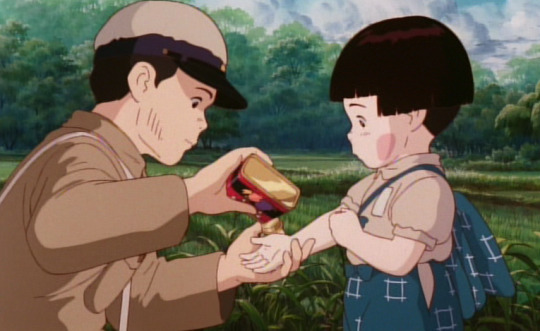
Last but not least, I have to mention Grave of the Fireflies. This tragic war film follows the story of Seita and Setsuko, a pair of siblings whose lives were overturned by the devastating war. If you're looking to have a good cry, I would highly, highly recommend this film.
Side note: A few years ago, people found that if you turn up the brightness on the movie poster, you can see the silhouette of a bombing plane in the sky. The little specks of light we all thought were fireflies are actually explosives. Just to rub salt in the wound.

Honourable Mentions!
Spirited Away
Ponyo on the Cliff By the Sea
Kiki's Delivery Service
When Marnie Was There
Princess Mononoke
#studio ghibli#ghibli#grave of the fireflies#totoro#my neighbor totoro#howls moving castle#ponyo#ponyo on the cliff by the sea#studio ghibli movies#hotaru no haka#howl no ugoku shiro#tonari no totoro#mononoke hime#princess mononoke#kiki's delivery service#when marnie was there#sen to chihiro no kamikakushi#spirited away#omoide no marnie#majo no takkyuubin
207 notes
·
View notes
Text
Avatar: The Last Airbender and intersectional feminism
A while ago I made a post going over some of the reasons why I believe Avatar: The Last Airbender (ATLA) is one of the greatest kids' shows of all time, so today I'm going to dive into a more specific area of the show.
One of the reasons why I enjoyed ATLA so much is due to its well-written and diverse selection of female characters. Too often do I witness shows create a female lead for the sole purpose of being the main character’s love interest, with no character traits or development.
In the case of ATLA, the female lead, Katara, is a kind and feminine but outspoken and strong-willed girl. She is an example of an intersectional feminist model as not only is she a woman of colour, but Katara also comes from the marginalised community of the Southern Water tribe. The series does not present her as Aang’s love interest, but rather a talented and skillful fighter who exhibits significant growth as a waterbender and a person throughout the series. In the episode entitled “The Waterbending Master,” Aang and Katara seek to learn waterbending from an expert named Pakku, but he refused to teach Katara due to the tribe’s sexist customs. But Katara wasn't having any of that. She challenges Pakku to a waterbending match. Though she losses, Pakku recognises her determination and talent and ultimately accepts her as a student.
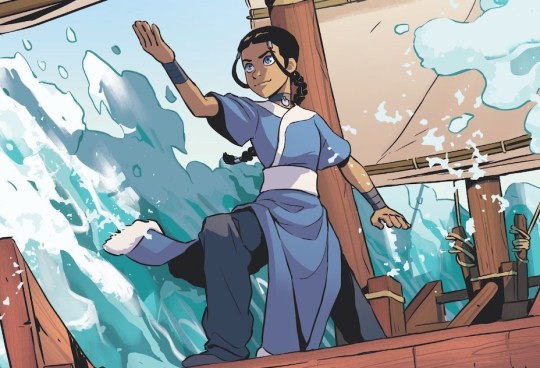
Another example of an intersectional model is Toph. Under the alias The Blind Bandit, Toph made a name for herself in the underground earthbending tournaments due to her remarkable skill as an earthbender (which is considered the most "raw" form of bending) despite coping with a physical impairment. She was arguably one of the best earthbenders of her time and yet she lived a sheltered childhood as her parents believed that her blindness made her fragile and incompetent. Eventually, she manages to break free of her shackles and joins Team Avatar on their adventures. Toph is fiercely independent, tough, and confident. She takes great pride in her earthbending skills, constantly reminding us that she is the "greatest earthbender in the world," and in my opinion, she definitely earned that title.
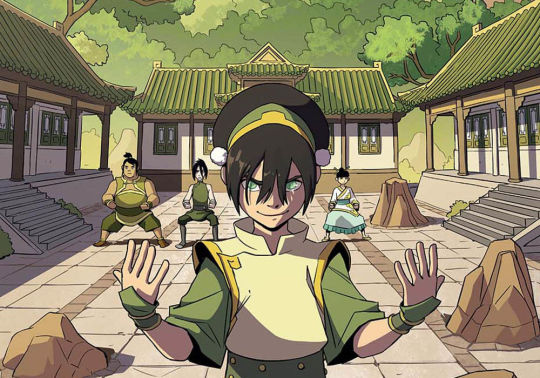
The last characters I want to talk about are the Kiyoshi Warriors. They are minor characters introduced early on in the series as an order of all-female warriors who train extensively in martial arts to protect their homeland. Sokka, who was occasionally sexist towards his sister, initially disliked the Kiyoshi Warriors as he felt humiliated by the fact that he was bested by "a bunch of girls." However, he is humbled and educated on gender equality by Suki, the leader of the warriors. Suki explains that her abilities as a fighter and her femininity are not mutually exclusive, and do not detract from one another.
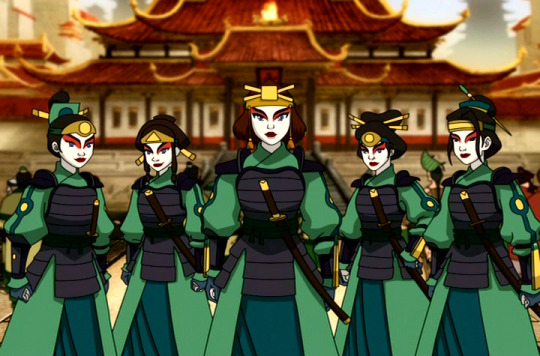
There are so many more characters I would've loved to talk about (shoutout to Azula, definitely one of my favourites) but these are the ones I really want to focus on. This show has undoubtedly presented us with a great female cast. Whilst they vary greatly in skill, personality and flaws, they are all very memorable and enjoyable to watch. ATLA focuses on depicting the capabilities of its female characters, without compromising their femininity as a result of their strength. Personally I think these types of characters are very important to young children, especially young girls, as it shows them they don’t have to act or look a certain way to be strong and capable. As a woman of colour, I would’ve loved to see more characters like Katara and Toph presented in media when I was a child.
#avatar the last airbender#katara#toph beifong#atla#intersectional feminism#azula#suki#sokka#ty lee#mai#avatar#the last airbender#kiyoshi warriors#toph#cartoon#nickelodeon#a:tla
132 notes
·
View notes
Text
Avatar: The Last Airbender and why it's more than just 'a kids show'

The first time I watched this show was only last year, but it has quickly become one of my favourite shows, and in my opinion, one of the best shows of all time. When I introduced it to my parents, they were reluctant to watch it because "that looks like a show for eight-year-olds," but quickly came to enjoy it as much as I did.
The story sets in a world inhabited by four nations, each representing one element: the Air Nomads, the Water Tribes, the Earth Kingdom, and the Fire Nation. Some people are born into the world with the ability to manipulate one of the elements to their will, and this skill is referred to as 'bending.' The balance between the four nations is maintained by the Avatar, the only person with the power to bend all the elements.
The main character, the twelve-year-old Aang, is the current Avatar and the last of the Air Nomads after his people were wiped out by the Fire Nation in a century-long war. Along with his friends Katara, Sokka, and later Toph, they venture through the world so he can master the four elements and bring an end to the oppression of the Fire Lord. In the meantime, Zuko, the banished prince of the Fire Nation, is on a mission to capture Aang as he believed that it would restore his honour.
Now at first glance this show may seem childish and shallow but do not be fooled-- the world-building is complex and completely unique. The show tackles important political themes that are very rarely presented in kids' media. Some of my favourite episodes are from the second season, in which the gang (or the gaang) travels to the Earth Kingdom. There they discover that the capital city is actually run by a shadow government of oppressive military police, and the King is simply a puppet head. Through the use of propaganda and brainwashing, the government manages to manipulate the thoughts of its citizens, making them completely oblivious to the fact that the four nations have been at war with each other for over a century. The episode "Lake Laogai" stood out the most for me, so keep an eye out on that episode, it sent shivers down my spine the first time watching it.
The show also discussed the idea of gender roles and patriarchy, sometimes in a very subtle manner, and this is often communicated through the female lead, Katara. This is in my opinion one of the most important lessons in the show, so I want to make a separate post going into more detail about ATLA and its depiction of femininity and strength.
There are so many more themes in this show and it would take all day for me to discuss each and every one of them, so I will list a few of them below. Give the show a watch and see how many of them you can spot: imperialism, genocide, classism, the environment, animal cruelty, colonialism, parental neglect, emotional and physical abuse
Despite its mature themes, there is still an abundance of comedic and heart-warming scenes. The show will make you laugh, cry, and most importantly, it will make you feel good when you finish. Many times shows capture our attention with an incredibly executed and promising start, only for the writers to fumble with the ending, leaving viewers disappointed and wanting for more. ATLA is not one of them. The quality of the writing and production is consistent throughout all three seasons, and in my opinion, the show gets better with every season. Everything leads up to an epic four-part finale that will have you on the edge of your seat. The ending should be more than satisfactory, but if you're still looking for more then fear not because there are still multiple comic books for you to read, following the adventures of the gang after the end of the animated show.
In conclusion, Avatar: The Last Airbender is truly one of a kind. If you're someone who watched the show as a child when it first aired, give it another go, you'll find that many of the themes discussed are still relevant today. You may also discover that there is an underlying meaning behind the story that you may not have noticed as a child. And if you're reading this deciding on whether or not you should start, I urge you give it a watch, I promise it's worth your time.
20 notes
·
View notes